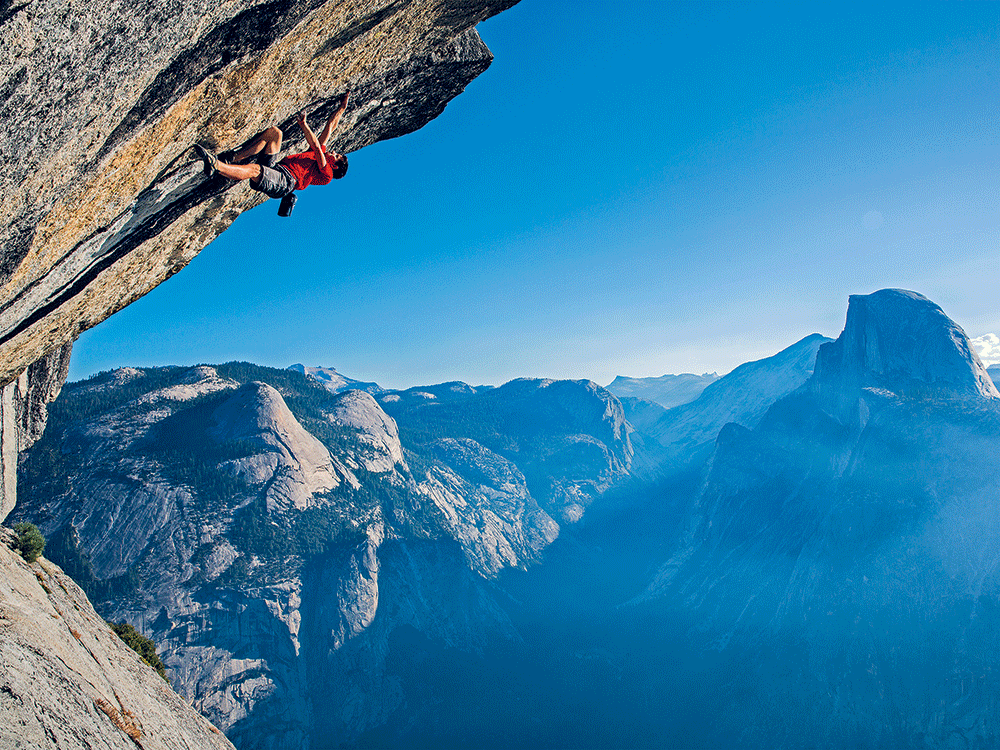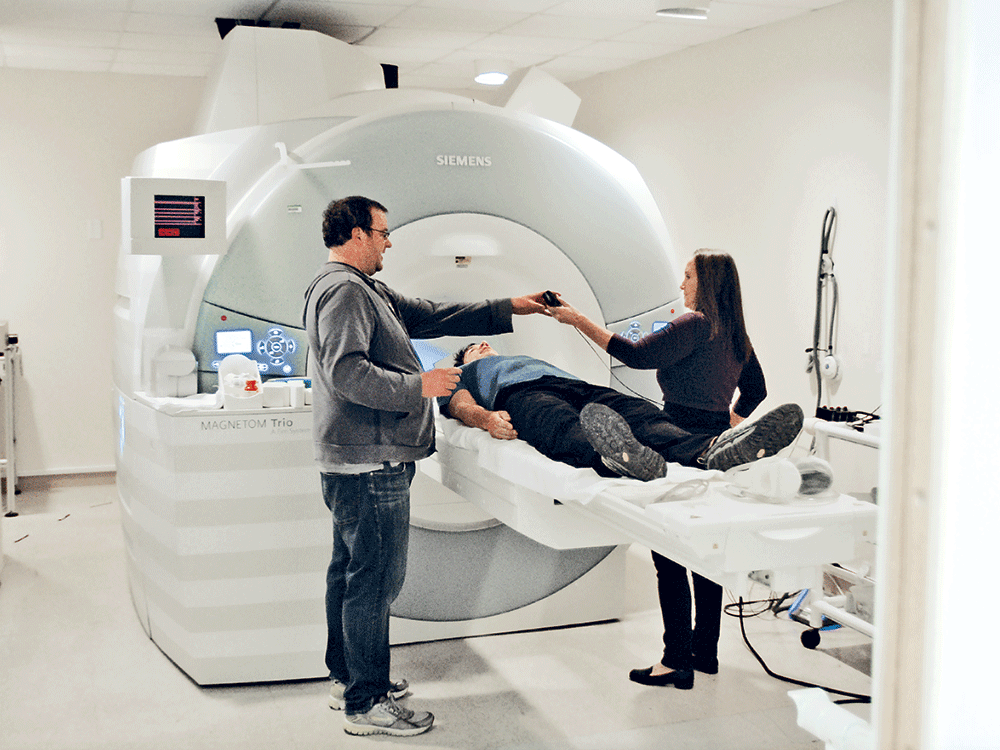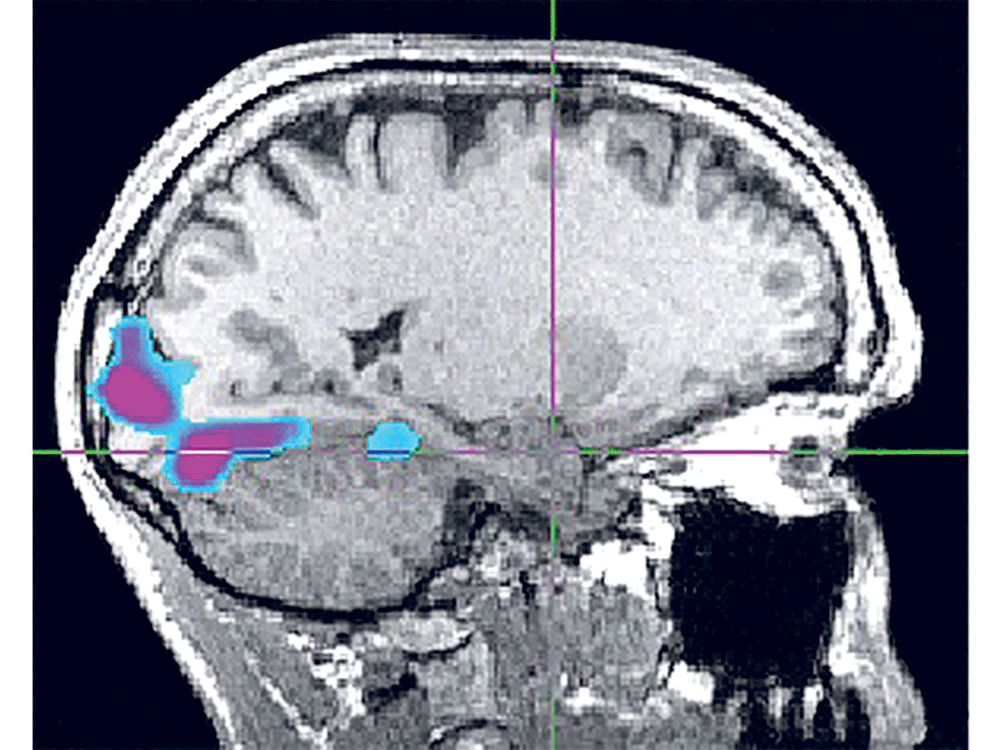
Life in the Death Zone
Alex Honnold has his own verb. “To honnold” is to stand in some high, precarious place with your back to the wall, staring into the abyss. To face fear, literally.
The verb was inspired by mesmerizing photographs of Honnold in precisely that position on Thank God Ledge, 550 metres off the deck in Yosemite National Park. In 2008, Honnold side-shuffled across this narrow sill of stone to become the first rock climber ever to scale the sheer granite face of the park’s iconic Half Dome peak alone and without a rope. Had he lost his balance, he would have fallen for 10 long seconds to his death on the ground below.
Honnold, 31, is history’s greatest free-solo climber, meaning he ascends without rope or protective equipment. Above about 15 metres, any fall would likely be lethal, which means that, on epic days of soloing, he might spend 12 or more hours in the “death zone”—the term used to describe the zone in which a ropeless rock-climbing fall would likely be fatal. On the hardest parts of some climbs, his fingers will have no more contact with the rock than most people have with their phones’ touchscreens, while his toes press down on edges the width of a stick of gum.
All of this has also made Honnold the world’s most famous climber. He has appeared on the cover of National Geographic, on 60 Minutes, in commercials for Citibank and BMW and in a trove of viral videos.
He also inspires no shortage of peanut-gallery commentary that something is wrong with his wiring. In 2014, he was part of an expedition team that gave a presentation at the National Geographic Society headquarters in Washington, D.C. The audience was there to hear from climbing photographer Jimmy Chin and veteran explorer Mark Synnott, but above all, they had gathered to gasp at tales about Honnold.
Synnott got the biggest response from a story set in Oman, where the men had travelled by sailboat to visit the remote mountains of the Musandam Peninsula. Coming upon an isolated village, they went ashore to mix with the locals. “At one point,” Synnott said, “these guys start yelling and pointing up at the cliff. And we’re like, ‘What’s going on?’ And of course I’m thinking, ‘I’m pretty sure I know.’”
Up came the photograph. There was Honnold, the same casual dude who was sitting onstage in a grey hoodie and khakis, looking like a toy as he scaled a huge, bone-coloured wall behind the town. He was alone and without a rope. Synnott summed up the villagers’ reaction: “Basically, they think Alex is a witch.”
When the presentation ended, the adventurers autographed posters for the crowd. Three lines formed. In one, a neurobiologist waited to share a few words with Synnott about the part of the brain that triggers fear. The scientist leaned in close, shot a glance toward Honnold, and said, “That kid’s amygdala isn’t firing.”

Inside Honnold’s Head
At one time, Honnold tells me, he would have been afraid—his word choice—to have psychologists and scientists looking at his brain and probing his behaviour. “I’ve always preferred not to look inside the sausage,” he says. “If it works, it works. Why ask questions? But now I feel like I’ve sort of stepped past that.”
And so, on this morning in March 2016, he is laid out, sausage-roll style, inside a large, white tube at the Medical University of South Carolina, in Charleston. The tube is a functional magnetic resonance imaging (fMRI) brain scanner, essentially a huge magnet that detects activity in the brain’s different regions by tracing blood flow.
The cognitive neuroscientist carrying out the scan is Jane Joseph, who in 2005 was one of the first people to perform fMRIs on high-sensation seekers—people who are drawn to intense experiences and who are willing to take risks to have them. Psychologists have been studying sensation seeking for decades because it often leads to out-of-control behaviours such as drug addiction and problem gambling.
In Honnold, Joseph initially anticipated the typology of a typical high-sensation seeker, but, some scans later, another possibility arises: the super sensation seeker, who pursues experiences at the outer limits of danger yet can tightly regulate the mind and body’s responses to them.
“I’m excited to see what his brain looks like,” Joseph says as the scan begins. “Then we’ll check what his amygdala is doing, to see: does he really have no fear?”
Often referred to as the brain’s fear centre, the amygdala is more precisely the centre of the brain’s threat-response and interpretation system. It allows us to, for example, step back from an unexpected precipice without a conscious thought. Its response to stressful stimuli also triggers other sensations familiar to almost everyone: racing heartbeat, sweaty palms, tunnel vision.
Meanwhile, the amygdala sends information for higher processing in the brain’s cortical structures, where it may be translated into the conscious emotion we call fear.
An initial scan of Honnold’s brain appears on MRI technician James Purl’s computer. “Can you go down to his amygdala? We have to know,” says Joseph.
Purl scrolls down until two almond-shaped nodes materialize. “He has one!” says Joseph, and Purl laughs. Whatever else explains how Honnold can bring himself to climb without a rope, it isn’t because there’s an empty space where his amygdala should be.
Inside the tube, Honnold is viewing a series of images that flick past at the speed of channel surfing. The photographs are meant to disturb or excite. “At least in non-Alex people, these would evoke a strong response in the amygdala,” says Joseph. The selection includes corpses with their facial features bloodily reorganized; a toilet choked with feces; and invigorating mountain-climbing scenes.
Check out these 10 inspiring adventures across Canada!

Mind Over Matter
Visualization—which we might think of as pre-consolidation in lay terms, whereby a person pictures a future event rather than a past one—works much the same way. “To review move after move, you’d expect that he did consolidate his motor memory and as a result probably had an increased sense of competence,” Monfils says.
Feelings of competence, in turn, have been shown to reduce anxiety, which helps explain why, for example, people who are fearful of public speaking (as Honnold used to be, by the way) feel less anxious about it as they do it more often, developing and reinforcing their skills in the process.
“The idea of the super sensation seeker—who is defined by having this motivation to pursue these kinds of positive and thrilling experiences but at the same time having control and regulation over his responses—is important,” says Joseph. “I think it could teach us a great deal about potentially treating substance-abuse and anxiety disorders.”
For example, many high-sensation seekers’ problematic behaviours involve intense experiences that can be pursued impulsively and without immediate consequences, such as binge drinking or drug use. (Honnold has always avoided alcohol and drugs.) Joseph wonders if that energy could be redirected into high-arousal activities—such as rock climbing, but with protective gear—that by their nature involve constraint, premeditation and specific goals, reinforcing different life patterns.
At the very least, it might be possible for any one of us to work a bit of Honnold’s magic. You may not have the traits of a super sensation seeker or be able to quench your amygdala on command, but with effort and gradual, repeated exposure to what we fear, any one of us might muster courage we didn’t know we had.
The next time I catch up with Honnold, he’s climbing with his girlfriend, Sanni McCandless, in Europe. I want to know if his new awareness of his atypical brain has affected his sense of self. No, he says, the discovery that his amygdala sleeps in his brain like an old dog in an Irish pub hasn’t changed anything. But that isn’t to say it hasn’t given him pause for reflection.
On a recent rest day from climbing, he says, he and McCandless decided to try a via ferrata near Lauterbrunnen, Switzerland. This is a kind of climbing route with artificial holds, such as rungs and ladders. The climber wears a safety harness, which, of course, Honnold didn’t bother with.
“But at a certain point, I was like, actually, this is kind of hardcore. Like I needed to pay attention,” he says. The via ferrata, it turned out, climbed across a rock wall on a series of rebar rungs set 914 metres off the valley floor. The weather threatened, McCandless was near tears, and after recent rains, water streaked down the limestone face and onto the handholds, footholds and their heads.
“I definitely thought about how I process fear,” Honnold says. What he realized was that, at least in this case, he didn’t. He’d been in similar situations so many times that it had become normal. There was nothing to process. “This is not scary,” he said to himself, “because this is what I do.”
Check out this mother and son’s once-in-a-lifetime kayaking adventure!
From “The Strange Brain of the World’s Greatest Solo Climber,” by J.B. MacKinnon, Nautilus (August 11, 2016). nautil.us